Fishing Grubs?
If You're Not You Need To Read Further
And Become A Grub Chunker!
Not fishing grubs? Why not? You can "chunk em", "bump em", "drag em", "swim em", "buzz em", "crank em" even "hop and drop em". Fish them in rivers, lakes, reservoirs and ponds. This usually small, nondescript soft plastic lure is truly a bait for all seasons and all types of water. Don't overlook what has recently become the "stepchild" of plastic lures.
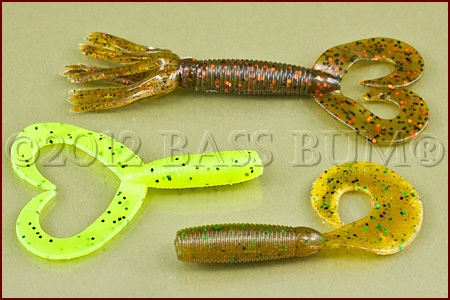
Let's Learn How To Catch Bass Fishing These Little Morsels
First Things First
What's the best tackle setup to use?
Spinning tackle is the first choice, especially
for catching smallmouth bass. Fishing a 2" to 4" single or twin
tail grub, calls for light line much of the time so a spinning outfit is
the best choice. If you're fishing a larger, bulkier "Hula" style like what is
sometimes called a spider grub, 5" or longer, baitcasting gear is
better.
A 6' to 6'6" medium action rod and medium size spinning reel spooled with 8Lb or 10lb line is a good all around choice when fishing lakes and reservoirs. However, when fishing smaller rivers for smallmouth I use a couple of lighter outfits:
- St. Croix, 5"6", medium fast, 6-12lb line, lures 1/4 to 5/8oz matched with a Shimano Saros 3000F reel
- St. Croix, 6', light power, fast action, 4-8lb line, lures 1/16 to 5/16oz, matched with a Shimano Symetre 1000FJ reel
I've found these perform well and provide great fun when hooked up to the river smallies and "spots" we have in rivers throughout Tennessee.
"What size do I use? Should it be a single or twin tail grub?
Listen, 3", 4" and 5" grubs are going to meet most all your needs. Sure, there are grubs available now that are 6", 7", 8" even longer. Don't know about you, but these sure seem to fall into the category of what I've always referred to as, "worms". But that's what the primary "long grub" manufacturer, Gary Yamamoto, calls them. Far be it from me to criticize what a man of such success in the world of lure making wants to call his lures.
However, I've found some short 2 1/2" Power Bait grubs from Berkley, rigged on a short shank 1/16oz ball head jig, to be "killer" on river smallmouth. I'm telling you. There are days when the smallmouth are swimming around your ankles begging for you to make your next cast with these little grubs. Well, perhaps I exaggerate a little, but they do a great job catching river smallies.
In any event, most bass fishermen use 3", 4" or 5" grubs for most applications. There are occasions when a bit longer grub might be used, such as when fishing grubs as topwater baits or in the fashion of a crankbait. We'll get into this later.
So grab several packages of 3", 4" and 5" single tail grubs (remember they're inexpensive) in smoke, pumpkin seed, white, clear and watermelon, add a bag of Spider and twin tail grubs, and go at it. Put to practice some of the techniques you'll find later on this page and I'll bet you catch some bass fishing grubs.

"What about color?"
You can find a plastic grub in almost every color in the rainbow and then some. It seems I have most of them and I use most on occasion. Remember, I'm a junk fisherman and unabashed experimenter with lures and tackle and fishing grubs is no exception.
I'm also quite certain, based on my experience, that any color will catch bass on any given day. However, I'm also certain some colors more than others will improve your odds of catching bass fishing grubs. For example:
- Smoke, motor oil, white and clear are good colors in clear water and on sunny days, especially in the later part of spring and most of fall. These colors closely resemble those of baitfish. Get grubs in translucent (somewhat clear allowing light to pass through) colors that also include some gold or silver flakes in them. This will add a little flash to their action when the sun is bright. On overcast days metal flakes will lose most of their flash. Fishing grubs that contain "flat" accents like black, red, blue or chartreuse are better choices when skies are overcast.
- Pumpkin Seed, watermelon with red flakes, or any combination of green, orange, brown and yellow will work to imitate the colors of crawfish. Try and determine the color of the craws in the water you're fishing and go with the closest color to that.
- Chartreuse is a very effective color when you're targeting smallmouth bass. Why? I haven't the slightest idea. I'd stay away from it in ultra clear water and on sunny days. But, on those cloudy days, when it's maybe even sprinkling rain, pull this color out. You'll be glad you did.
These are colors most bass fishermen use fishing grubs most of the time and with good reason. They more or less "match the hatch" and catch bass. But think about this. If these colors are what bass see most of the time it's inevitable that most bass will be caught on these colors. However, the fact that chartreuse is in the bunch tells me other colors bass don't usually see in their habitat will also catch them. So if you want to experiment with color combinations do so fishing grubs as they are an inexpensive plastic bait. You just might find a color that produces for you and which can be your own little secret.
"How do I rig them?"
Jigheads (leadheads) Rule!
By fishing grubs on leadheads and varying the weight of the head you can fish most any depth. The best jighead styles for grubs are the round ball and darter jigheads, though football heads are good for larger grubs like the "Hula" style.
There are a few basic things to consider when choosing a jighead. If in shallow water stick with smaller size leadheads of 1/16, 1/8 or 1/4 ounce. When in water deeper than 15' or rapid river current a 3/8 ounce is good.
Generally speaking, leadheads of 1/8, 1/4 and 3/8 ounce will meet the demand of 75-80% of the situations in which you will be fishing.
When fishing grubs in brush it's best to Texas Rig your grub in order to minimize hang ups. As with a leadhead, be sure and line up the hook exit point with the "seam". The hook should exit the grub at the point where the body and tail join. A light wire, wide gap hook is a good choice as most grubs are "fat". Wide gap hooks make the best grub hooks due to the "fat" bodies of most grubs.
You can fish a Texas rigged grub on a Carolina Rig, Split-Shot rig (4"-5" grub) or when using it as you would a topwater (5"-7" grub) or jerk bait (5"-7" grub).
Nose Hooked
Grubs are good baits for drop-shotting, especially for "suspended" bass. Nose hook a 3" or 4" grub as you would any other "finesse" type bait for this technique. I've had particularly good success doing this with a 3" Berkley "Gulp" Minnow Grub in pearl white and red.
Grubs As Trailers
Hard lures, like jigs with skirts, can be softened by adding a twin-tail grub. The soft texture of the grub will cause the bass to hold on a bit longer and give you more opportunity to feel it and set the hook.
They're good trailers for spinnerbaits too. Use a single tail grub here.
"OK, I have it rigged. Now, how and where do I fish it?
You almost have to try fishing grubs incorrectly. The basic "chunk it out and work it back to the boat" retrieve like a plastic worm works. However, there are far more ways to make this little gem of a bait even more effective.
The following are presentations you can use when fishing plastic grubs:
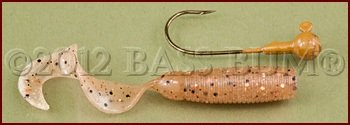
Bouncing Off The Walls
During cold water periods, put a small, single tail grub on a little 1/16oz jighead and head for the bluffs. Bounce this slowly down the wall from ledge to ledge.
I've found the small 2" Berkley Power Grub on a 1/16oz ball head jig to work well for this presentation.
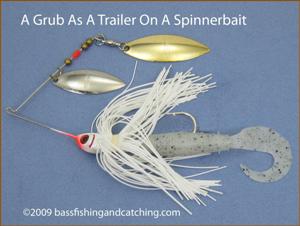
Bringing Up The Rear
If you fish spinnerbaits adding a grub as a trailer can draw strikes from bass that first hear/feel the vibration of the blades and them see the grub as a baitfish.
If you also use a "stinger" hook let it dangle loose. Don't stick it through the rear of the grub then slide the hook eye of the main hook barb. Doing this would greatly inhibit the action of the grub's curly tail.
The same applies to fishing grubs as trailers on buzzbaits.
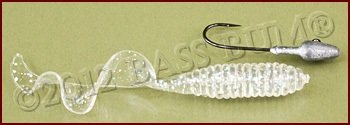
Grubs Are Good Swimmers
A grub swims quite nicely on a darter head jig, whose shape enables it to move well through grass and to a lesser extent brush. You can swim this setup back to your boat while passing it closely by your cover target. A "hawg" lurking inside may surge out to ambush your grub.
Or, you can rig it weedless on a wide gap hook and a small bullet sinker and cast it to the cover letting the grub drop all the way to the bottom. If you're not hit on the drop slowly lift your rod tip to about 10:00 then allow it to drop again. It will appear to bass as a baitfish swimming up and down from the bottom.
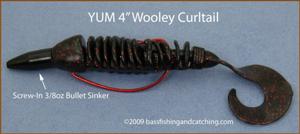
Grubs In Vegetation
Fishing grubs on jigheads with an exposed hook is not such a good idea around grass. However, a 4" or larger grub rigged Texas style with a 3/8 or 1/2 ounce screw-in style bullet sinker can be flipped or pitched smack into the middle of grass.
If you are a line watcher you might want to use a slip sinker instead of a fixed/pegged sinker.

Drop Shot Grubs
I've found a 2-3 inch plastic grub to be great a drop-shot bait. One in particular with which I've had success is the 3" Berkley "Gulp ! Alive!" Minnow Grub. White, chartreuse and red work well for me.
Carolina Rigged Grubs
Carolina rigs with 3", 4" and 5" plastic grubs can work well in cold water periods. Fish them in areas close to deep water such as main channel drop offs. I must tell you though, that if you're fishing grubs on a Carolina rig in cold water it's probably best not to rig the grub weedless. Wintertime bites can be very light and setting the hook can be tricky. Of course, this exposes you to a higher probability of "hang ups".
Split-Shotting Grubs
Fishing grubs, small ones, on the end of a split-shot rig is great for working areas with plain bottoms or gravel covered points that are free of brush. This is a good technique when fish are not very active and are not likely to "chase down" a meal.
Work this setup "slowly" along the bottom. Point your rod tip at the water and start to slowly reel. Then move your rod tip to the side sweeping it back gently and keeping the shot touching the bottom. Stop reeling, return your rod tip to your front and take up the slack. Repeat this back to the boat.
Alternatively, you can retrieve your grub "up" off the bottom at the depth you think the bass are holding.
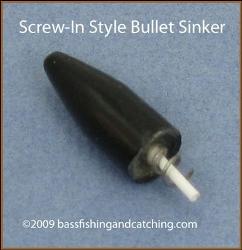
Grubs Buzz On Top
If you have any small 1/8 ounce "screw-in" bullet sinkers, you can use a fast retrieve to convert your grub into an almost "silent" buzzbait. The tail will flap wildly churning water and this disturbance will alert bass. There are bass that will readily take this bait while avoiding the noisy, clacking, squealing of a traditional buzzbait.
Crank A Grub
Fishing grubs as crankbaits can be very effective. While retrieving your "topwater" grub, you can simply slow your retrieve, let the grub sink a bit and "Wa-La", you have a weedless crankbait. This can be very effective around and through shallow cover without the aggravation of hanging up. It gives the bass a different look that is slower and less violent in its movement than a regular treble hooked crankbait.
Grubs And Schooling Bass - Fun!
Chasing schooling bass in the fall is something most all bass anglers look forward to. Many different lures can be thrown to schooling bass but fishing grubs for this can be particularly effective. A grub can catch them when they're thrashing baitfish on the surface and when they lurk below waiting for stragglers.
Put a 4" plastic grub on a 1/4oz leadhead tied to 10lb monofilament. A spinning rig works best as you can chunk this setup a country mile, which is what you want to do. Cast past the surface busting bass and retrieve into them holding your rod high. This will bring your grub along the surface into the "maddening crowd" of bass. Once there, let the grub drop a few feet. A bass will see this as an injured baitfish drifting helplessly to the bottom and WHAM! They'll knock the snot out of it.
Take note, it's usually the bigger bass lurking around the edges and below the school waiting for an easy meal. They let the smaller youngsters do all the work banging the baitfish on top with wild abandon while they wait patiently below to pick off the injured shad that are easy to catch.
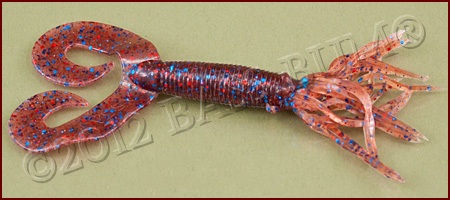
Aloha, Sweet Hula Grub
Grab a football head jig, 1/2oz or even 3/4oz, rig it with a Hula grub, and fish bluffs in warmer water periods working the ledges like walking down steps. You're looking for bluffs that bottom out around 25' for this. Once it lands on a ledge slowly lift your rod tip and "crawl" the grub to the edge allowing it to fall to the next. There is a good chance you will drop into the living room of a bass as you work your way down.
Hula (Spider) grubs, sometimes called spider grubs, are great crawfish imitators. On rock strewn bottoms fish a Spider grub on a 3/8oz jighead, preferably a football head. Crawl it along the bottom in 10-15' of water. Find some "pockets" and simply cast into the back of these then slowly crawl the grub out. You can also mix in a few hops along the way which might get you a reaction strike.
And You Thought Fishing Grubs Was Simple!
Return To Bass Fishing Techniques From Fishing Grubs
